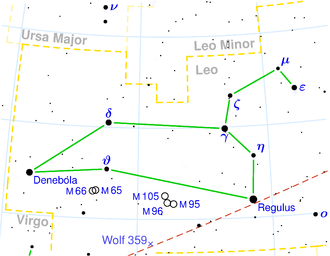NGC 3926
| Galaxy NGC 3926 |
|
|---|---|

|
|
| SDSS recording | |
| AladinLite | |
| Constellation | lion |
|
Position equinox : J2000.0 , epoch : J2000.0 |
|
| Right ascension | 11 h 51 m 28.2 s |
| declination | + 22 ° 01 ′ 33 ″ |
| Appearance | |
| Morphological type | 1/2: E / PAS |
| Brightness (visual) | 1: 14.5 mag 2: 14.7 mag |
| Brightness (B-band) | 2: 15.5 mag 2: 15.7 mag |
| Angular expansion | 1: 0.5 / 0.4 2: 0.9 / 0.9 |
| Position angle | 1: 117 ° |
| Surface brightness | 1: 12.8 mag / arcmin² 2: 14.5 mag / arcmin² |
| Physical data | |
| Redshift | 0.028343 ± 0.000070 |
| Radial velocity | 8497 ± 21 km / s |
|
Stroke distance v rad / H 0 |
(378 ± 26) · 10 6 ly (115.9 ± 8.1) Mpc |
| history | |
| discovery | Wilhelm Herschel |
| Discovery date | April 26, 1785 |
| Catalog names | |
| NGC 3926 • UGC 6829 • PGC 37079/37080 • CGCG 127-076 • MCG + 04-28-074 / 073 • VV 218 • GC 2589 • H III 379 • h 998 • | |
NGC 3926 is a pair of galaxies , both elliptical galaxies of the Hubble type E-S0, in the constellation Leo , which is an estimated 360 million light years away from the Milky Way .
The galaxy was discovered on April 26, 1785 by the astronomer Wilhelm Herschel with his 18.7-inch reflecting telescope.
